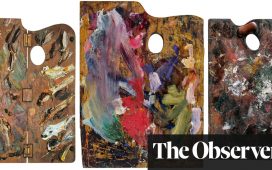Turning 40 was always going to be tricky for the Turner prize. Set up in 1984 to showcase the best in contemporary British art, the prize will for ever be remembered for Damien Hirst’s dead shark, Tracey Emin’s unmade bed and Martin Creed’s empty room with the lights going on and off. Riding the crest of Cool Britannia in the mid-to-late 90s, the Turner prize – and those headline-grabbing Young British Artists – helped make London an international cultural powerhouse. And it wasn’t just animal carcasses. Winners included luminaries such as Antony Gormley, Steve McQueen and Grayson Perry.
By 2001 it was so starry that Madonna presented the award. While the Turner remains the best-known art prize in the world, it is unlikely Taylor Swift would make space in her diary today. Can this one-time enfant terrible grow old gracefully without losing its vigour and urgency? Is it still a reliable index of the most exciting work on the British arts scene?
Not according to some reviews of the latest shortlist exhibition, which returns to Tate Britain for the first time in six years. The four prize finalists are Claudette Johnson, acclaimed for her lifesize portraits of Black women; the Philippines-born artist Pio Abad, who explores colonial histories; Jasleen Kaur, whose installations reflect her upbringing as a Glaswegian Sikh; and Delaine Le Bas, whose work celebrates her Romani background. After a few years in the post-pandemic doldrums, this exhibition, with standout images such as Kaur’s vintage red Ford Escort covered in a huge doily and Abad’s giant concrete bracelet, might signal a return to the Turner’s swaggery heyday. The Guardian’s Adrian Searle found a show full of humour and “cultural collisions”, and another critic judged it a return to form. But other reviewers diagnosed a mid-life crisis and declared it “an embarrassment”, even calling for the prize to be overhauled or put out to grass.
Questions about its direction are perhaps inevitable. Over the years, the cries of “is it art?” have become irrelevant, due in part to the prize’s success in making contemporary art part of our cultural conversation. It is impossible to imagine Lisa Nandy dismissing the exhibition as “conceptual bullshit”, as the then culture minister Kim Howells did in 2022.
The prize has sometimes struggled to find the balance between challenging assumptions and maintaining a sense of fun – the decision to shortlist only collectives in 2021 risked prioritising a social statement over audience excitement. But, in its four decades, the Turner has rightly adapted to address issues such as access (with the show now hosted outside London every other year) and inclusivity. In 2017, the age cap of 50 was removed to reflect the fact that many artists – in particular women and artists of colour – had been overlooked and were producing their best work later in life: Lubaina Himid at 63 became the first Black woman to win the prize.
It would be an absurd act of cultural self-sabotage to scrap the Turner. It remains a global force, attracting thousands of visitors to galleries across the country, and it still has the power to transform the careers of little-known artists. It may no longer be young and edgy, but it must be allowed to continue to evolve and reinvent itself.








